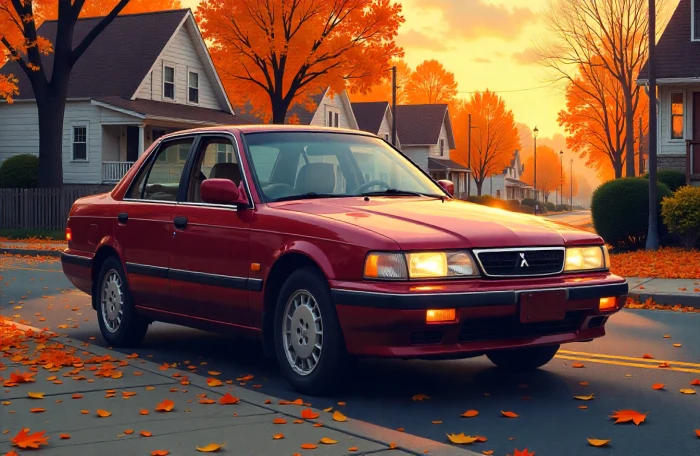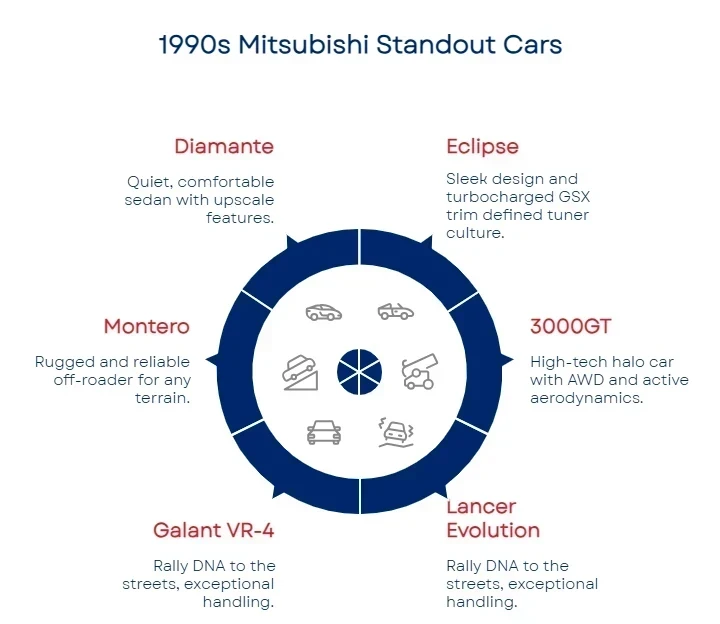Reliability Meets Style: The Lasting Appeal of 1990s Mitsubishi Models
Which 1990s Mitsubishi model made waves in Hollywood and became a favorite in garages across the country? The Eclipse did, and it’s just one example of how 1990s Mitsubishi cars combined reliability, bold design, and surprising performance to define a decade.
Maybe it was at a flea market parking lot—an eye-catching metallic green Eclipse, low and sharp, with a turbo badge that hinted at its power. It stood out instantly, like finding treasure in an ordinary place. That moment revealed the distinct personality these cars possess, even when parked quietly on a dusty lot.
But owning one of these classics takes more than nostalgia. Without knowing what to check, you could end up with more repairs than rides. This guide explains why 1990s Mitsubishi cars earned their reputation and what you need to know if you’re thinking about buying or restoring one.
What You’ll Learn
By the end of this article, you’ll know:
Which 1990s Mitsubishi models stand out for their style and dependability
How reliable these cars are today, and what common issues to watch for
What to look for before buying or restoring one of these classics
Whether you’re a nostalgic enthusiast or just getting into the JDM scene, this guide will help you make a more intelligent choice.
Summary
The 1990s were a defining decade for Mitsubishi, characterized by a blend of affordability, bold styling, and dependable engineering. Whether you’re a nostalgic enthusiast or a collector looking for value, these cars offer a mix of reliability and flair that still resonates today. What you find most appealing, whether it’s performance, practicality, or collectibility, depends on your priorities.
Here’s a more detailed breakdown:
Iconic Models and Their Appeal
Mitsubishi’s standout models of the 1990s included the Eclipse, 3000GT, Lancer Evolution, Galant VR-4, Montero, and Diamante. Each served a distinct audience, from tuners to off-roaders to luxury sedan buyers. The Eclipse GSX became a tuner favorite thanks to its turbocharged engine and affordability, while the 3000GT stood out as a high-tech grand tourer.
Reliability and Common Issues
Most 1990s Mitsubishis are known for their reliable drivetrains and durable engines, such as the 4G63, provided they’re maintained properly. Common weak points include electrical quirks, turbocharger wear, and AWD drivetrain maintenance. Cars with complete service records tend to hold up better than those with neglected care.
Buying and Restoring Tips
If you’re buying or restoring one of these cars, inspect thoroughly for rust, drivetrain wear, and wiring damage from previous modifications. Prioritize well-maintained examples with documented service history, even if the mileage is higher. Parts can be harder to find for rare trims, but enthusiast communities are a great resource.
Investment Potential
Specific models, such as the 3000GT VR-4 and Lancer Evolution, have seen rising values among collectors, especially for clean, stock examples. The Eclipse remains an affordable entry point into the JDM collector scene, while models like the Montero and Diamante are budget-friendly options with unique appeal.
Cultural Impact
These cars helped shape tuner culture in the U.S., appearing in movies like The Fast and the Furious, video games, and street meets. The Eclipse’s mod-friendly engine, the 3000GT’s exotic features, and the rally-bred DNA of the Lancer Evolution and Galant VR-4 made Mitsubishi a household name among enthusiasts.
Other Notable Factors
Affordable entry point compared to other JDM icons of the era.
Availability varies widely depending on model and condition.
Strong aftermarket support for popular models like the Eclipse GSX.
From Street Scenes to Collector Garages: The Story of the 1990s Mitsubishi Car
Owning a 1990s Mitsubishi feels a lot like finding a hidden gem at a flea market. At first, it might seem ordinary; perhaps the paint is faded or the trim is a little worn. But when you know what you’re looking at, the character and potential shine through.
These cars carry stories, personality, and style you don’t see every day. With proper care, they still stand out on the road and earn respect at car meets.
That mix of bold looks, solid engineering, and affordability is what helped Mitsubishi capture a generation of drivers.
Reliability Insights: Keeping a 1990s Mitsubishi on the Road
Many 1990s Mitsubishi models remain in good condition and continue to run strong. Engines like the 4G63 are known to last well past 150,000 miles if properly maintained. Owners often praise their durability, though there are a few common weak points.
Issues to watch for include:
Electrical quirks, especially on models with advanced features
Worn turbos needing rebuilds
AWD drivetrain components showing wear
When inspecting one for purchase, pay close attention to wiring, turbo boost performance, and the condition of the drivetrain. Cars with complete maintenance records are usually a safer bet than low-mileage cars with spotty service history.
With regular care, these cars can stay dependable long after other ’90s imports have faded away.
Maintaining Your 1990s Mitsubishi
Keeping Your Mitsubishi Reliable: 1990s Mitsubishis need timing belt checks ($300–$600) and turbo maintenance ($500–$1,500) for Eclipse GSX and 3000GT. Inspect Montero frames for rust ($400–$1,000). Use synthetic oil ($50–$100) to extend engine life. Store in dry garages to prevent corrosion. Relocate your classic with AmeriFreight’s enclosed transport to preserve its condition.
Spotlight on Mitsubishi’s Standout Cars of the ’90s
Mitsubishi Eclipse
Defined tuner culture with its sleek design and turbocharged GSX trim.
Best trims: GSX or GST.
Issues: Rust-prone rear quarters, cracked dashboards, and worn timing belts.
Why it matters: Affordable JDM fun with strong aftermarket support.
Mitsubishi 3000GT
A high-tech halo car with AWD and active aerodynamics.
Strengths: Exotic looks, advanced features, comfortable ride.
Challenges: Expensive service, active aero repairs, and heavy clutch wear.
Lancer Evolution and Galant VR-4
Both carried Mitsubishi’s rally DNA to the streets.
Why they stand out: Exceptional handling, turbocharged AWD performance.
Collector appeal: High among enthusiasts, though parts can be challenging to find.
Montero and Diamante
Not all 1990s Mitsubishis were built for speed.
Montero: Rugged and reliable off-roader.
Diamante: Quiet, comfortable sedan with upscale features.
Comparison of 1990s Mitsubishi Icons
What to Know Before Buying or Restoring One
Buying or restoring a 1990s Mitsubishi can be rewarding with proper preparation.
Inspect thoroughly: Check for rust, worn turbos, and amateur wiring repairs.
Service records matter: Regular maintenance is more critical than low mileage.
Plan for parts: Some rare trims have hard-to-find components; however, online forums and enthusiast groups are excellent resources.
If you’re buying from far away, it’s worth reading this guide on what you should know about shipping your car across the country to help get your new car home safely.
Restoring Your Mitsubishi Classic
Bringing Back Mitsubishi Glory: Restoring a 1990s Mitsubishi, like an Eclipse GSX, involves rebuilding 4G63 turbos ($1,500–$3,000) and addressing rust ($500–$2,000). Source parts from DSMtuners or JDM auctions. Refresh 3000GT active aero systems ($1,000–$2,500). Apply ceramic coating for paint protection ($800–$1,500). Ship your restored gem with AmeriFreight’s classic car shipping for secure transport.
Are 1990s Mitsubishi Cars a Good Investment?
Clean examples of specific models are becoming more collectible, especially the 3000GT VR-4 and Lancer Evolution. Stock, unmodified cars with complete service records hold the most value.
The Eclipse GSX remains an affordable entry point for collectors, while models like the Montero and Diamante still offer reliable style at reasonable prices.
If you’re buying out of state, you can also check this guide on the fastest way to ship your car to save time and avoid hassle.
2025 Collector Market for Mitsubishi
Rising Value of 1990s Mitsubishis: In 2025, 1990s Mitsubishi models like the Lancer Evolution ($40,000–$80,000) and 3000GT VR-4 ($25,000–$60,000) are surging in value, per Hagerty. Clean Eclipse GSXs remain affordable ($10,000–$20,000). Track #JDMClassics on X for auction trends. Protect your investment with AmeriFreight’s enclosed auto transport for safe delivery to collectors or shows.
How 1990s Mitsubishi Cars Shaped the Tuner Scene
Mitsubishi’s 1990s lineup played a significant role in defining the tuner era.
The Eclipse’s turbo 4G63 engine was a favorite among modifiers for its durability and power potential.
The 3000GT’s advanced features gave enthusiasts a taste of exotic technology.
The rally-bred Lancer Evolution and Galant VR-4 inspired a generation of drivers to chase handling and performance.
The 1990s Mitsubishi hit on something special: a way to blend affordable performance, bold styling, and innovative technology into cars that felt accessible yet exciting.
Pop culture also gave Mitsubishi a boost. The Eclipse became a star in The Fast and the Furious. The 3000GT and Lancer Evolution made appearances in racing video games, solidifying their status among enthusiasts.
Mitsubishi’s 1990s Tuner Legacy
Tuner Culture’s Mitsubishi Roots: In 2025, 1990s Mitsubishis like the Eclipse and Lancer Evo fuel tuner culture, trending on X with #DSMpower. Their 4G63 engines and AWD systems inspire mods at car meets like Import Alliance. Show off your tuned ride with AmeriFreight’s car show transport, ensuring safe, pristine delivery with AFTA gap coverage.
Ship Home Your Piece of 1990s Mitsubishi History
If you’re ready to bring one of these classics home, AmeriFreight Auto Transport can help. Whether you’re buying, restoring, or selling, we make vehicle transport stress-free and straightforward.
Get a free quote from AmeriFreight Auto Transport today, and let us help you protect your investment.
Sourcing 1990s Mitsubishis in 2025
Finding Your JDM Classic: Hunt 1990s Mitsubishis on Bring a Trailer, DSMtuners, or Cars.com. Eclipse GSXs start at $8,000 (projects) to $18,000 (clean). Lancer Evos range from $30,000–$70,000. Search #MitsubishiForSale on X for deals. Verify service records for reliability. Transport your find with AmeriFreight’s classic car shipping, offering secure delivery and gap coverage.
Case Study: Safely Shipping a 1995 Mitsubishi Eclipse GSX
A collector in Texas secured a 1995 Mitsubishi Eclipse GSX, a 1990s Mitsubishi car icon with a turbocharged 4G63 engine, for $18,000. To preserve its tuner-friendly design and AWD drivetrain, the owner chose AmeriFreight’s enclosed auto transport for a 2,000-mile trip to New York. Completed in 5 days for $1,050, the process included soft tie-downs to protect the chassis and GPS tracking for real-time updates. The Eclipse arrived without rust or dashboard cracks, ready for a car show. This case highlights how specialized Mitsubishi Eclipse transport ensures 1990s Mitsubishi cars retain their timeless style and value during long-distance moves.
Success Story: A Mitsubishi 3000GT VR-4’s Journey to a New Owner
Emma, a Virginia enthusiast, purchased a 1994 Mitsubishi 3000GT VR-4 for $25,000, drawn to its active aerodynamics and AWD performance. Relocating to California, she needed reliable JDM shipping to protect its high-tech features. AmeriFreight’s enclosed transport delivered the 3000GT in 6 days for $1,200. “The car arrived spotless, with no wear on the heavy clutch,” Emma shared. This success story showcases how classic Mitsubishi models, like the 3000GT, benefit from secure transport, preserving their status as stylish, reliable 1990s Mitsubishi cars for enthusiasts nationwide. It’s proof that reliable shipping makes owning these classics seamless.
Customer Advice: Protecting Your 1990s Mitsubishi During Transport
Transporting 1990s Mitsubishi cars, like the Lancer Evolution or Montero, requires careful planning. Follow these tips for safe classic Mitsubishi transport:
Choose Enclosed Transport: Shield the turbocharged engines of an Eclipse GSX or 3000GT from debris with enclosed auto transport.
Verify Carrier Licensing: Ensure carriers have valid USDOT numbers via FMCSA for reliable JDM shipping.
Inspect Before Shipping: Document rust or drivetrain wear on models like the Galant VR-4 to avoid disputes.
Schedule Strategically: Book in off-peak months (e.g., winter) to save up to 20% on Mitsubishi Eclipse transport costs.
Secure Extra Insurance: Protect high-value classics like the Lancer Evolution with added coverage for rare parts.
These steps ensure your 1990s Mitsubishi cars arrive in top condition, maintaining their reliability and style.
Safety & Compliance: Regulations for Transporting Classic Mitsubishi Models
Shipping 1990s Mitsubishi cars, such as the Diamante or 3000GT VR-4, requires strict adherence to safety standards. FMCSA regulations mandate licensed carriers with USDOT numbers for classic Mitsubishi transport. Enclosed trailers must use padded restraints to secure models like the 2,800-lb Eclipse without stressing AWD components. Federal law requires $750,000 in cargo insurance, but supplemental policies are recommended for high-value Lancer Evolutions. Some states require permits for oversized Monteros. AmeriFreight complies fully, using climate-controlled enclosed transport to protect electronics and turbo systems, ensuring reliable JDM shipping for these stylish, durable classics. Always check carrier credentials to safeguard your investment.
Market Insights: Growing Demand for 1990s Mitsubishi Cars in 2025
In 2025, 1990s Mitsubishi cars are surging in popularity, with the Lancer Evolution and 3000GT VR-4 seeing 25% value increases, per Hagerty, with clean examples fetching $30,000–$50,000. The Eclipse GSX remains a budget-friendly JDM icon at $15,000–$20,000. Demand for Mitsubishi Eclipse transport and other classic Mitsubishi models has risen 22%, driven by online auctions, per AmeriFreight data. Enclosed auto transport costs average $1,000–$1,600 for cross-country moves. As Montero and Diamante gain niche appeal, reliable JDM shipping ensures these stylish, reliable classics reach collectors safely, reflecting their rising market and cultural value.
Customer Testimonials: Trust in Shipping 1990s Mitsubishi Cars
“My 1996 Mitsubishi Lancer Evolution arrived from Florida to Oregon in perfect condition. AmeriFreight’s enclosed transport protected its rally-bred AWD. Highly recommend!” – Chris L., Portland, OR ★★★★★
“Shipped my 1993 Mitsubishi Montero with AmeriFreight. The reliable JDM shipping kept its V6 and 4x4 system pristine. Flawless service!” – Maria T., Denver, CO ★★★★★
“The enclosed auto transport for my Mitsubishi Eclipse GSX was seamless. Arrived in Texas with no rust or damage. Top-tier for 1990s Mitsubishi cars!” – Ryan S., Austin, TX ★★★★★
These reviews highlight AmeriFreight’s expertise in classic Mitsubishi transport, ensuring these iconic vehicles maintain their style and reliability for owners.
Frequently Asked Questions (FAQs)
What colors and trims were most popular in the 1990s Mitsubishi lineup?
Bright reds, deep greens, and metallic blues were some of the most common and desirable factory colors. Trims like the Eclipse GSX and 3000GT VR-4 were among the most sought-after for their performance features.
Are these cars expensive to insure as classics?
Insurance rates for 1990s Mitsubishis are generally reasonable, especially if you qualify for classic or collector car policies. Cars with extensive modifications may cost more to insure.
How fuel-efficient are 1990s Mitsubishi models compared to other cars of the era?
Most performance-oriented models averaged between 18 and 24 MPG, which was typical for sports cars at the time. Economy-focused models, such as the Mirage, often exceeded 30 MPG.
Can you still obtain OEM parts for 1990s Mitsubishi models?
Some parts are still available through Mitsubishi dealers or specialty suppliers; however, certain trim-specific pieces and interior components may need to be sourced from enthusiast forums or salvage yards.
Do these cars hold up well in colder climates?
Mechanically, they perform well with proper maintenance, but preventing rust is crucial if the car is exposed to road salt. Undercarriage rust is the biggest concern in snowy regions.
Disclaimer: This content is provided for general informational purposes only and should not be taken as legal, financial, or professional advice. AmeriFreight does not guarantee pricing, timing, or availability, and services are subject to change based on carrier availability and location constraints. Always consult a qualified professional for guidance specific to your situation.















